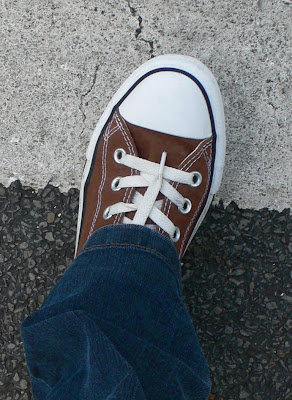Saint-Omer, the first pretty city after port-entry to France via Calais, is a training ground for freshly arrived tourists from England who haven't yet mastered the art of crossing French streets.
We used to live near Saint-Omer, where I did most of my shopping and a number of good deeds rescuing English people stranded at pedestrian crosswalks.
They would stand expectantly on the edge of the sidewalk waiting for each passing car to stop, then look confused and bewildered as indifferent drivers whizzed by. Their challenge was not simply breaking the English habit of looking right, left, then right again before crossing (the rest of the world looks left, right, left), but learning how the French traverse their rues.
French driving laws require cars to stop for pedestrians once they are "regularly engaged" in crossing the street. What that means is not explicitly set out in the French code, but my driving instructor explained to me that in general drivers here don't stop for a pedestrian until after he has placed a foot onto the street, and not before. If a pedestrian remains standing on the curb or sidewalk, even at a marked crosswalk, then drivers are neither obliged to stop to allow him to cross, nor likely to.
A caveat: The French Code also requires that pedestrians take into account the distance and speed of vehicles before crossing a street, and not to dart out into traffic, even if drivers are obliged to yield to pedestrians "regularly engaged" in crossing. Mind your toes.
Text & photo ©2009 P.B. Lecron
Of interest
A charming French children's book for young and old alike: Le lapin et la lune, écrit par Marianne Lecron, illustré par P. B. Lecron; and its English version, The Rabbit and the Moon. Both available on worldwide Amazon sites.
And another captivating tale rich with illustrations: Le Lapin et le Roi Grenouille and its English version, The Rabbit and King Frog. Click on the titles to have a peek! Sold worldwide on Amazon.
We used to live near Saint-Omer, where I did most of my shopping and a number of good deeds rescuing English people stranded at pedestrian crosswalks.
They would stand expectantly on the edge of the sidewalk waiting for each passing car to stop, then look confused and bewildered as indifferent drivers whizzed by. Their challenge was not simply breaking the English habit of looking right, left, then right again before crossing (the rest of the world looks left, right, left), but learning how the French traverse their rues.
French driving laws require cars to stop for pedestrians once they are "regularly engaged" in crossing the street. What that means is not explicitly set out in the French code, but my driving instructor explained to me that in general drivers here don't stop for a pedestrian until after he has placed a foot onto the street, and not before. If a pedestrian remains standing on the curb or sidewalk, even at a marked crosswalk, then drivers are neither obliged to stop to allow him to cross, nor likely to.
A caveat: The French Code also requires that pedestrians take into account the distance and speed of vehicles before crossing a street, and not to dart out into traffic, even if drivers are obliged to yield to pedestrians "regularly engaged" in crossing. Mind your toes.
Text & photo ©2009 P.B. Lecron
Of interest
A charming French children's book for young and old alike: Le lapin et la lune, écrit par Marianne Lecron, illustré par P. B. Lecron; and its English version, The Rabbit and the Moon. Both available on worldwide Amazon sites.
And another captivating tale rich with illustrations: Le Lapin et le Roi Grenouille and its English version, The Rabbit and King Frog. Click on the titles to have a peek! Sold worldwide on Amazon.














No comments:
Post a Comment